Home / A Conversation with Pinaree Sanpitak
Share this article:

Hello Pinaree, tell us about your journey as an artist. How did you come to art, and looking back, what have been the main sources of inspiration for you? Who or what has influenced your path as an artist?
Pinaree Sanpitak: I started out with photography works during my undergraduate course at The School of Fine Arts and Design, University of Tsukuba, Japan. I went to Japan because I got this 5-year full scholarship for tuition and living expenses. I was 19, not knowing a word of Japanese and open to anything. The whole experience was my foundation. I was the only foreign undergraduate student that year and the professors let me explore. There were 10 departments covering the scope of fine arts and design. By my senior year, under the guidance of Professor Kiyoji Otsuji (1923-2001), I was doing mixed-media work with photographs and hand-made paper, among the graphic design works of my classmates in the Visual Arts and Design department.
I saved up some money and went backpacking in the Philippines, Burma, Bangladesh, Nepal, India for a year before settling back in Bangkok. I knew then that I just wanted to work as an artist, gradually one thing led to another.
Looking back, I think the training in design seeps out a lot in my practice, through forms and symbols. I started my monograph from the year 1985 because I wanted to show how my works now relate and evolve from the works back then.

You have been exploring the ‘breast stupa’ motif in your art for several years now. How did you arrive at this signature motif, and what is it about this form that continues to fascinate you? (You have explored iterations of this motif in ceramics, painting, sculpture, and even performative works and in your cookery series as well.)
Pinaree Sanpitak: I coined the term “breast stupas” in 2001 as the title of a sculptural installation piece composed of de-threaded long swaths of silk pieces hanging from the ceiling, with somewhat elongated abstract breast shapes in the center, with all the bases near the bottom. It was 6 to 7 years since I started the “Breast Works”. The breast forms somehow became more sacred, more grounded, both from the making process and the setup.
The subject and the form of “breast stupas” intrigues me and I wanted to explore it at all angles. I paint them. I draw them. I sculpt them. I wanted to delve further with different materials and approaches. “Breast Stupa Cookery”, and “Breast Stupa Topiary” followed suit. The two projects deal with food and nature, two main necessities of human beings. Not one iteration is the same, which excites me. I don’t know the outcome. It’s a good practice of trust and letting go. And that is why I keep on at it.
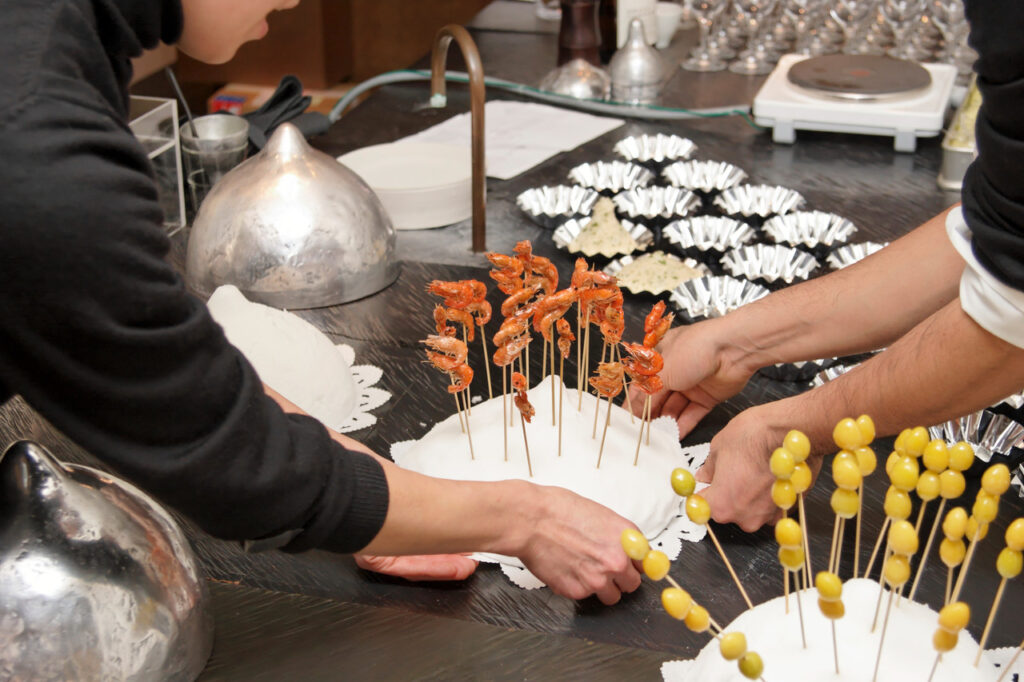
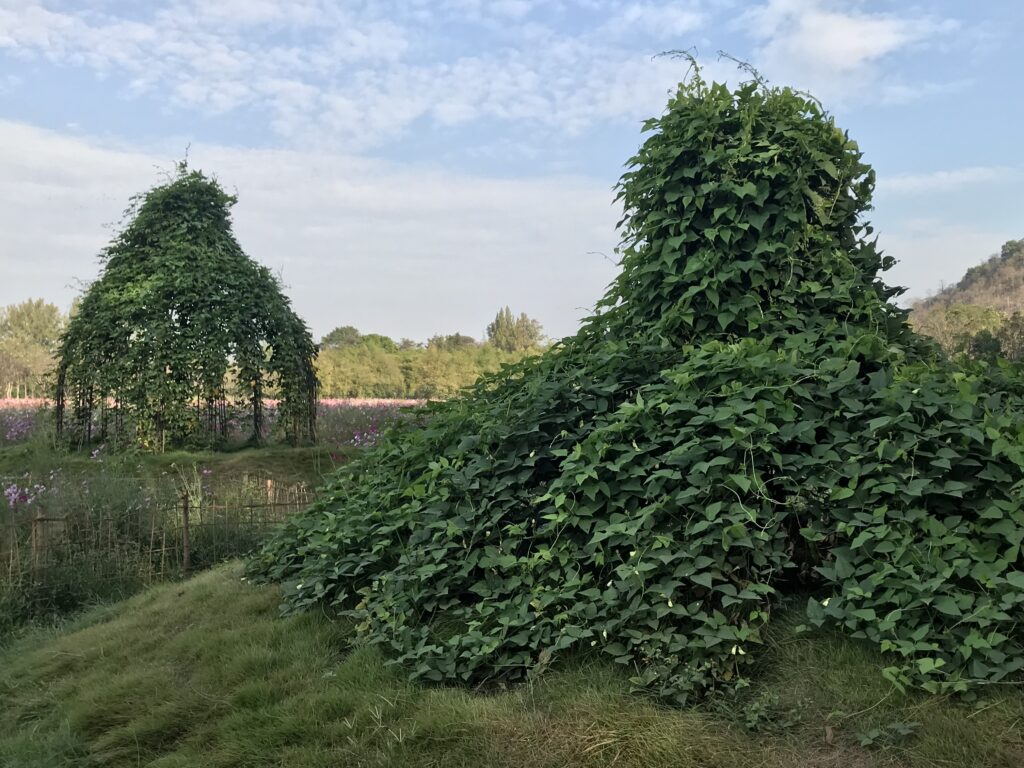
Another recurrent form in your work is that of the Ma-lai, which makes reference to the ubiquitous floral garlands in Thailand that serve as offerings as well as markers of significant occasions or passages in life. When did you first start to explore this motif in your work, and what fascinates you about this motif, and the process of making the toile sculptures?
Pinaree Sanpitak: The period before finishing “Breast Stupa Topiary” in 2013, I was incorporating dried flowers and garden elements into paintings. My studio in central Bangkok is connected to my kitchen and garden and these elements naturally come to be part of my works. It was also after I made the textile piece “Hanging by a Thread”. With “Ma-lai” I wanted to work on another textile piece and create one module that could be built into various configurations. I tried the idea with different textiles and tried to fold them into different shapes, similar to when we work with banana leaves or flower petals. I ended up with toile because of the natural colour tone and that it was a ‘simple’ and ‘basic’ textile. Ones that designers use when creating their ideas. There was a lot of toile around from Shone’s works[1]. With toile, the folds and structures hold their shapes and are visibly clear without any patterns on the textile. I intentionally left some edges with the fringes.
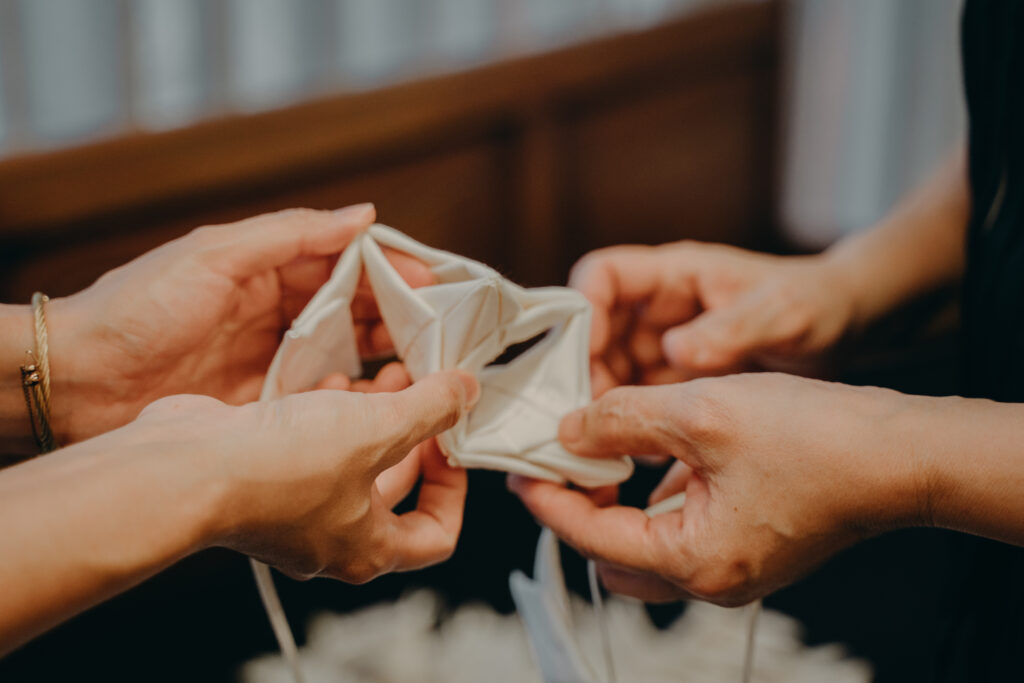

Your Ma-lai works – the folded toile sculptures – have been presented and installed in different contexts, for instance as large wreaths or garlands hung on the walls, on the occasion of your solo show in New York; as a floor-bound sculpture in the form of your work “Body Moves” at Yavuz Gallery; and more recently at Mrigadayavan Palace in Thailand. It also featured at your “Black and Red House”, a site-responsive installation for the Setouchi Triennale. How similar, or different, was your approach to these presentations? Does the Ma-lai tell a different story at each site?
Pinaree Sanpitak: As I said earlier that I wanted to make works which are able to build from a single module. The works after “Ma-lai: mentally secured” grew organically. I didn’t plan them from the beginning but rather developed each work according to sites and concepts of each project.
The first iteration, “Ma-lai: mentally secured” was based on the concept of the ‘body’ and the different forms of Ma-lai. They were in conversation with the works on canvas and the aluminum sculptures connected with actual flowers that would dry out during the course of the exhibition.
For “Body Moves” I was trying to make another hanging Ma-lai version but then after connecting the pieces in this particular structure, the whole piece was able to stand on its own and change with every move. That was how I came to the conclusion to present the work as is, thus the title, “Body Moves”. Maybe in the future I’ll attach the piece to a device to move it around like a dance piece.
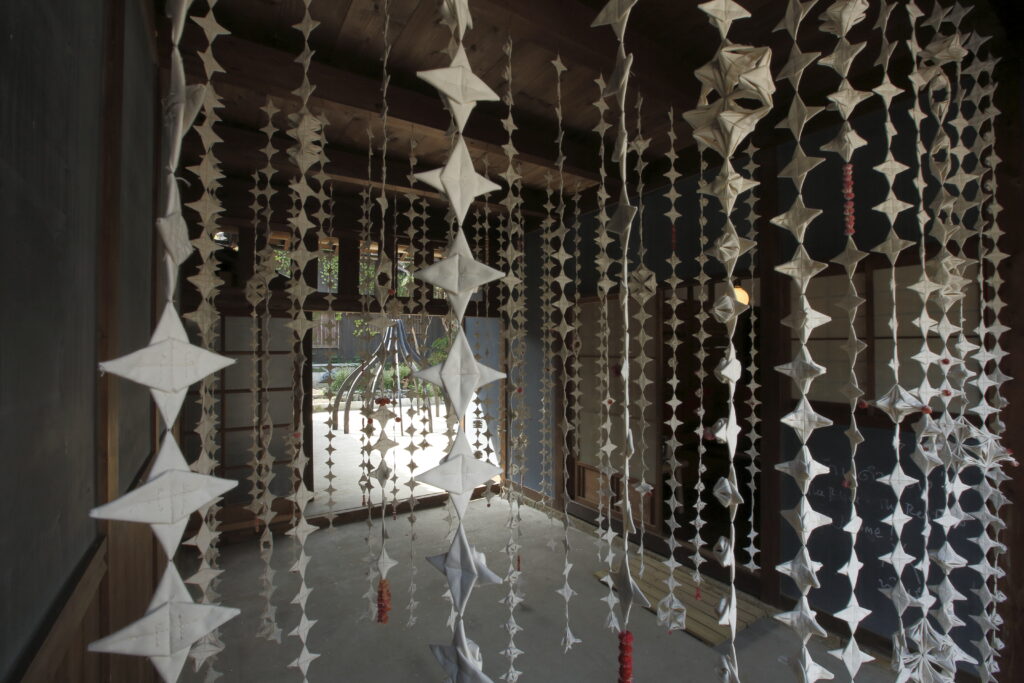
The long strands of Ma-lai mixed with Baan Mai Roo Roi (Globe Amaranth) flowers at Jim Thompson Farm (2018) and at “The Black and The Red House” on Honjima Island for the Setouchi Triennale (2019) were meant to be a welcoming symbol. On Honjima, we planted the red flowers and used them to strand afterwards. The meaning of the flowers in Thai (Baan Mai Roo Roi, everlasting bloom) and in Japanese (Sennichiko, red flowers lasting 1000 days) are similar, and relates with the project to collaborate with the people of Honjima, whose population has been dwindling through the years with only the elderly and children left (counting 330 in 2018). The project is also honouring the crafts masters of wood and paper as well.
The Mirigadayavan Palace[2] version incorporated scent, made from traditionally made infused organic fruits and plants inserted in the pockets of the Ma-lai placed in the hallway of the inner court work rooms. A pair of “Ma-lai-Connected” was placed on the balcony with local beach forest vegetation inserted between the sculptures. We attached name tags of the plants to each branch. I wanted the “Ma-lai” to connect not just with the craft, architecture and historical aspect but also with the environmental issue which the Director, Klaomard Yip-intsoi has been extensively researching on, for example beach erosion and the encroachment of alien beach forest vegetation.
When a work expands to new sites and contexts, it’s not just about placing the objects but truly making a connection through the artworks.
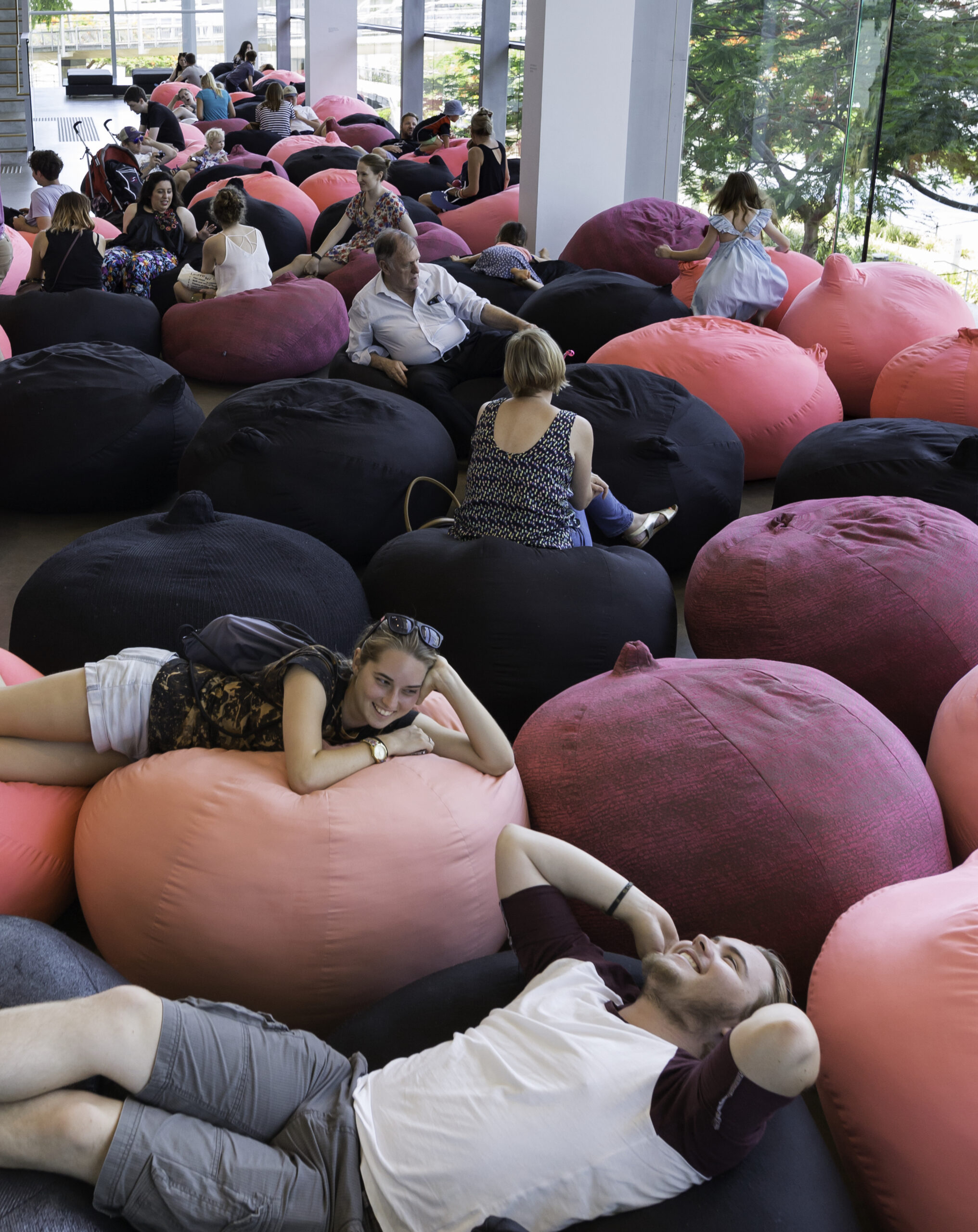
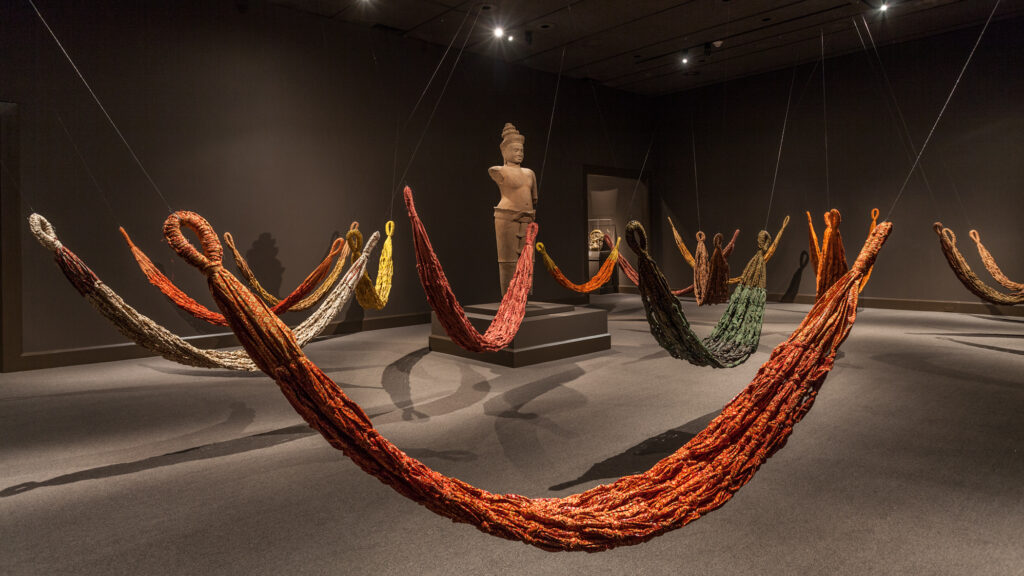
Another item which recurs in your work is the cushion or pillow, an object that connotes ideas of comfort, rest, and solace. This takes on various forms, for instance the breast-shaped cushions of “Noon-Nom” which was presented at the Singapore Art Museum as well as at QAGOMA in Australia. And then there were the khid pillows, which made up your installation “The House is Crumbling”, commissioned by the National Gallery Singapore. A related work for me would be “Hanging By A Thread”, presented at the Los Angeles County Museum of Art, USA, which conflates ideas of comfort and refuge in the image of the suspended hammock, made from hardy paa-lai fabric which was also found in the flood relief bags distributed in Thailand by the royal family. Like “The House is Crumbling”, there is also an implicit sense of precariousness in this work. Could you say more about why you keep returning to these forms and ideas? What is it about these works that you feel addresses these times that we live in, or aspects of the human condition?
Pinaree Sanpitak: I planned on “Noon-Nom” since 2001 while working on the show “Vessels and Mounds” at the National Gallery Bangkok, and realised the first version in 2002. The “Noon-Nom” of 2016, shown at QAGOMA, is more mature, more bold. When QAGOMA asked me to show “Noon-Nom”, after 14 years I didn’t want to show the original but rather a new version. In a way you can also see these works as self-portraits. I asked Shone to help create the patterns for “Noon-Nom” 2016.
The khid pillows in “The House is Crumbling” evolved from the installation “The Mats and The Pillows” at Tyler Rollins Fine Art in New York the year before, but this time with 16 strings attached. The National Gallery Singapore requested an interactive installation. I wanted it to be accessible and meaningful to all ages. It is also a one-module work that can expand.
Yes, the softness of “Noon-Nom” relates to the sense of comfort, nurturing and being sensual. The khid pillows creates a sense of construction, space, comforting with urgency and instability. Yes, it relates to “Hanging by a Thread”. I still feel the precariousness. Life is always precarious.
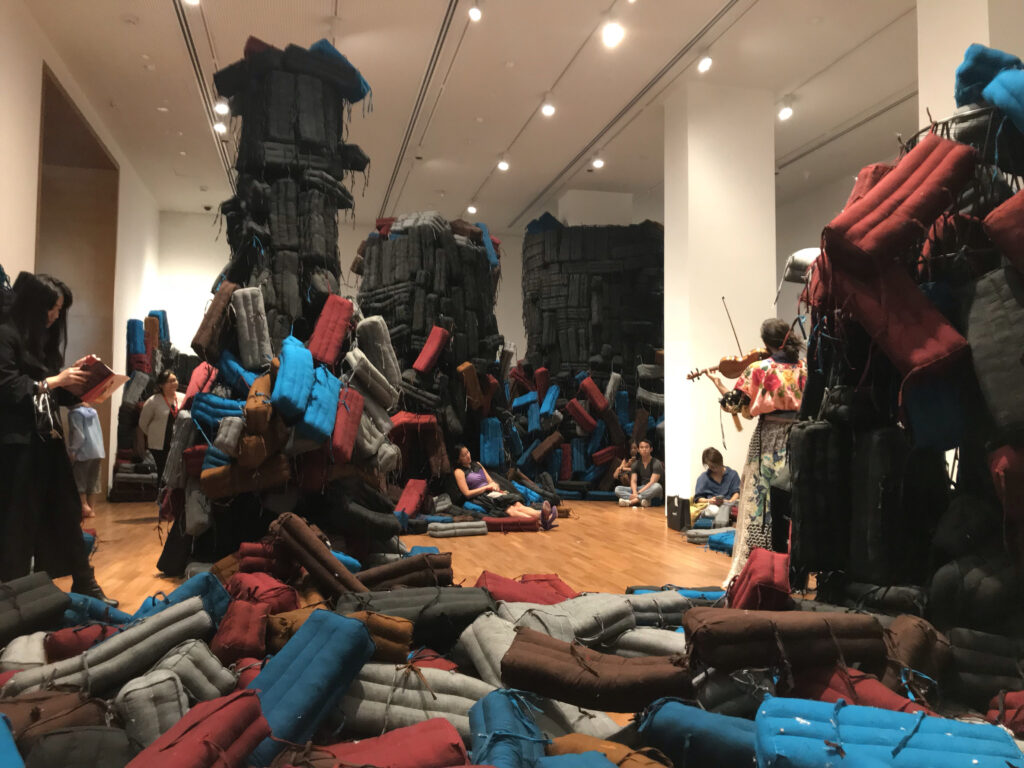
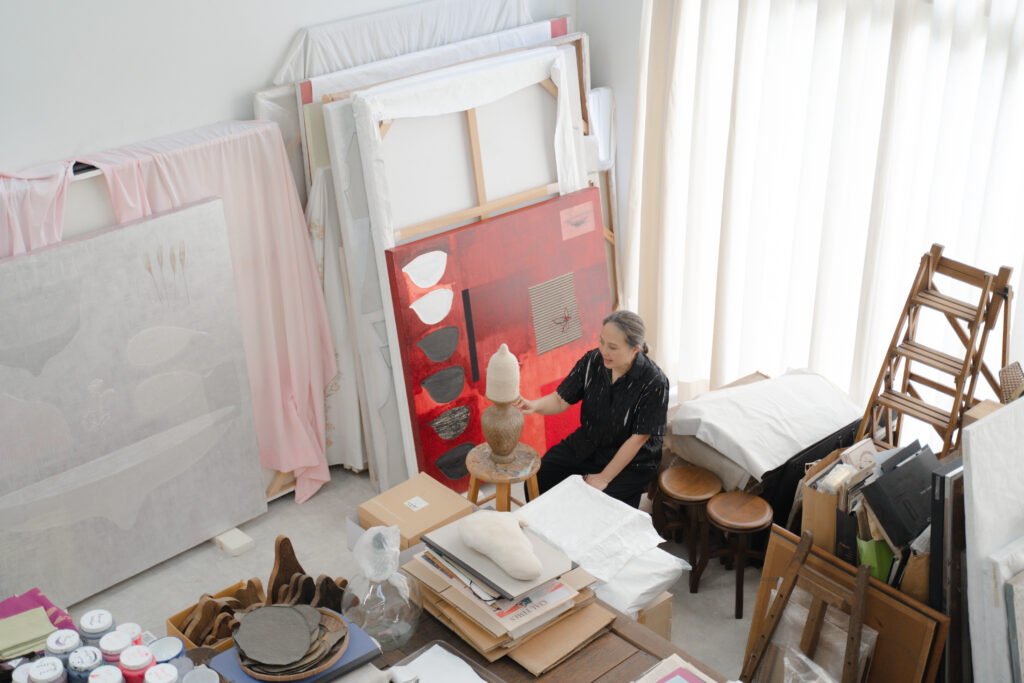
This is a very busy year for you. Can you say a little more about your upcoming projects? What works will you be presenting at each exhibition, and how do they continue the narratives explored in earlier iterations of each motif, or take it in a different direction?
Pinaree Sanpitak: I’ve been fortunate with timing these past years through the pandemic. This May I will be part of a group show at the Hancock Shaker Village (HSV) in Massachusetts, USA, together with two other artists: Kimsooja and Yusuke Asai. The show was postponed from last year, but I have been in discussion with the curator, Miwako Tezuka, for some time before.
I was interested to work with the Shaker Village project because of their fundamental beliefs, aesthetic and craftsmanship. The Shaker community balances out gender roles in such an exemplary manner in line with their principles. These are the key words from a video documentary that stayed in my mind:
Perfection
No Ornament
Spiritual
Deliberate Simplicity
No fight against gravity
No dirt in heaven
Flat broom
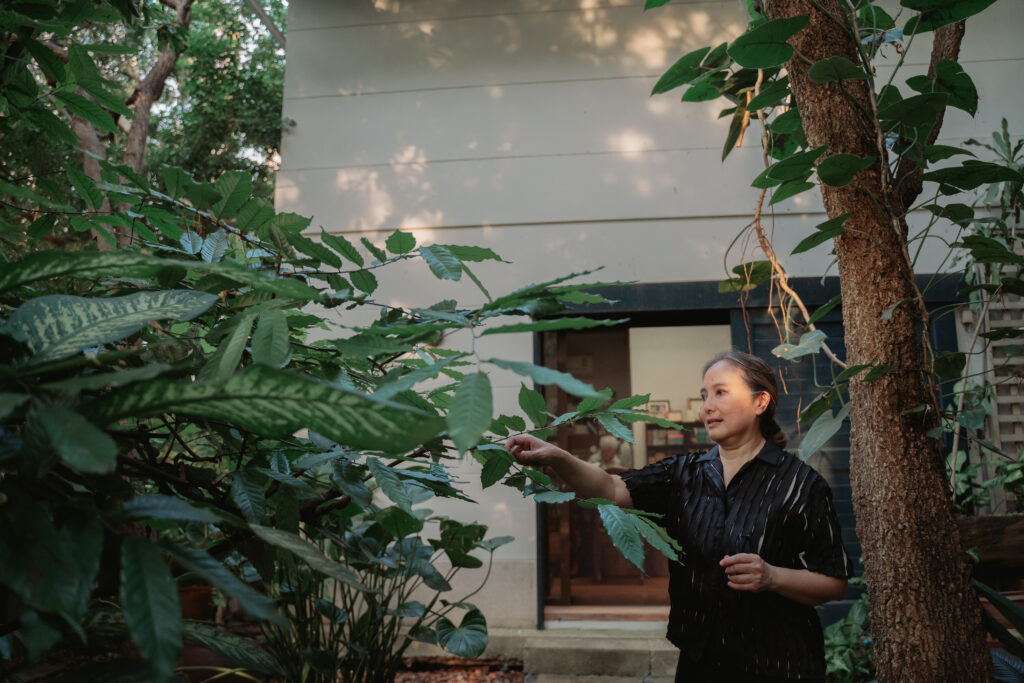
Due to Covid-19, I did not pursue the survey trip as intended and planned the whole project so that it is flexible enough in case I cannot be present but is still immersive and collaborative. The site I was allocated is called the “Brick Dwelling”. I suggested “Breast Stupa” hand-torn-stacked paper sculptures to be placed in the kitchen, dining hall, medicinal herbs room and beside a red cloak to create a dialogue with the Shakers’ aesthetic and way of life. Outdoors we are working on building “Breast Stupa Topiary” with metal artist, Edward Martin. The Shakers come from an agricultural background and here the working farm which started since 1783 continues. “Breast Stupa Topiary” connects directly with the Shakers’ earth and the seeds. During the 6-month course of the exhibition, the chef will collaborate through “Breast Stupa Cookery”, also incorporating the home-grown vegetables from HSV. The title of the exhibition is “A Spirit of Gift, A Place of Sharing”. The three “breast stupa” projects bring together the sacred and sensuality to the Shakers’ history, beliefs, way of life and craftsmanship.

The upcoming show with Yavuz Gallery in Sydney is titled “The Body and The Vessel”, showing an installation of trolley sculptures and paintings. The new sculpture works for Yavuz Gallery Sydney and Hancock Shaker Village have evolved from the 2020 installation “House Calls”. At Yavuz, I was looking into a way to make the sculptures move as with the shelves in “House Calls”, and discovered these mid-century trolleys (the same generation as me!) The trolley sculptures are called “The Affairs of Serving” and will be shown along a series of new works on canvas continuing from the series I am presenting at the Venice Biennale.
I am very honored and pleased that Cecilia [Alemani] has chosen my paintings for Venice. When I heard about the 3 themes of her curatorial intent: the representation of bodies and their metamorphoses, the relationship between individuals and technologies, the connection between bodies and the Earth…I thought which works? Because any of my works would fit the criteria. We decided on a salon style hang on a 6 x 7 meter wall. It’s very different when you hang paintings in a linear position. I had a certain time limit to work so had to plan well. It was challenging. The whole wall creates a fluid story.
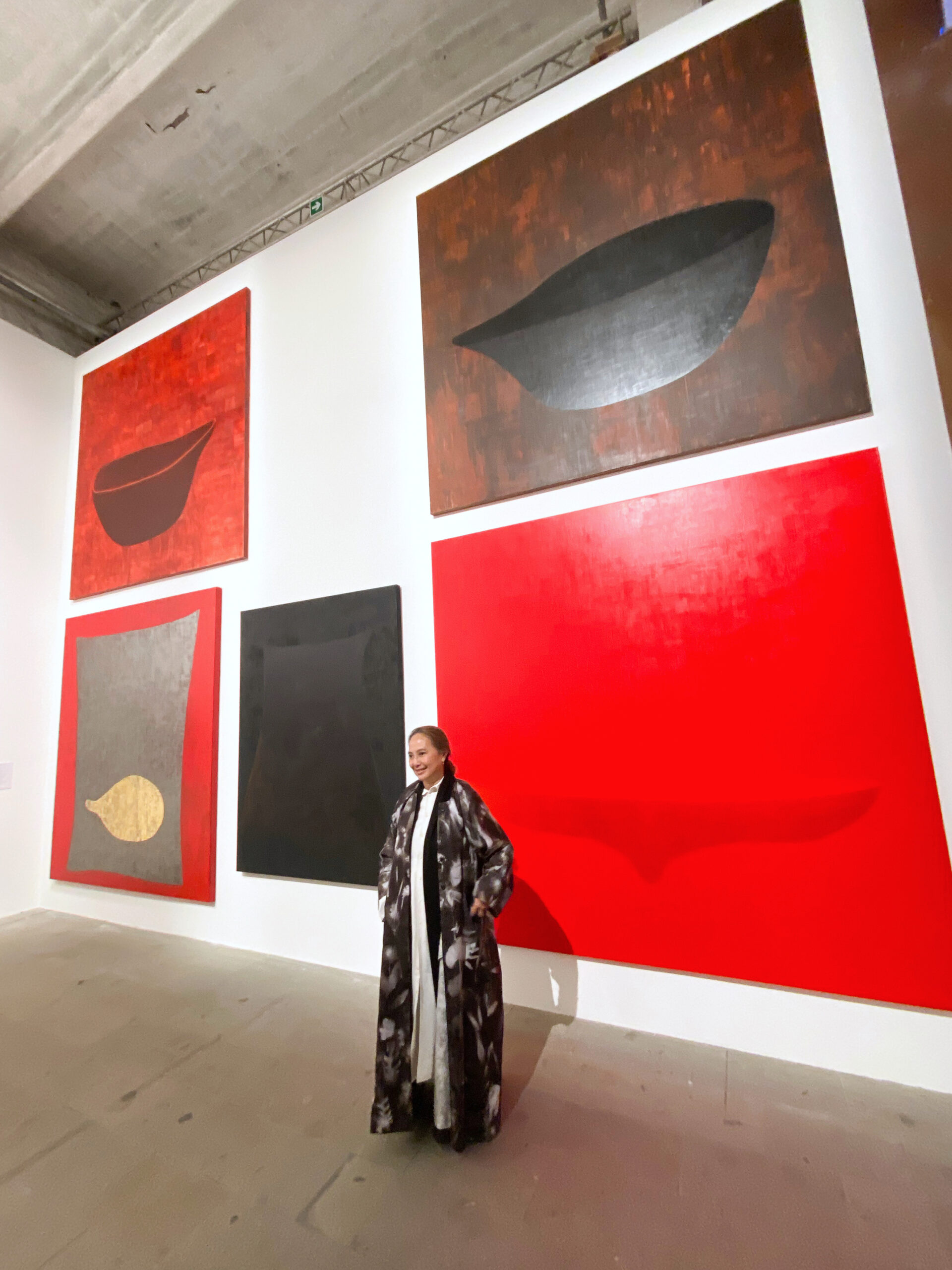
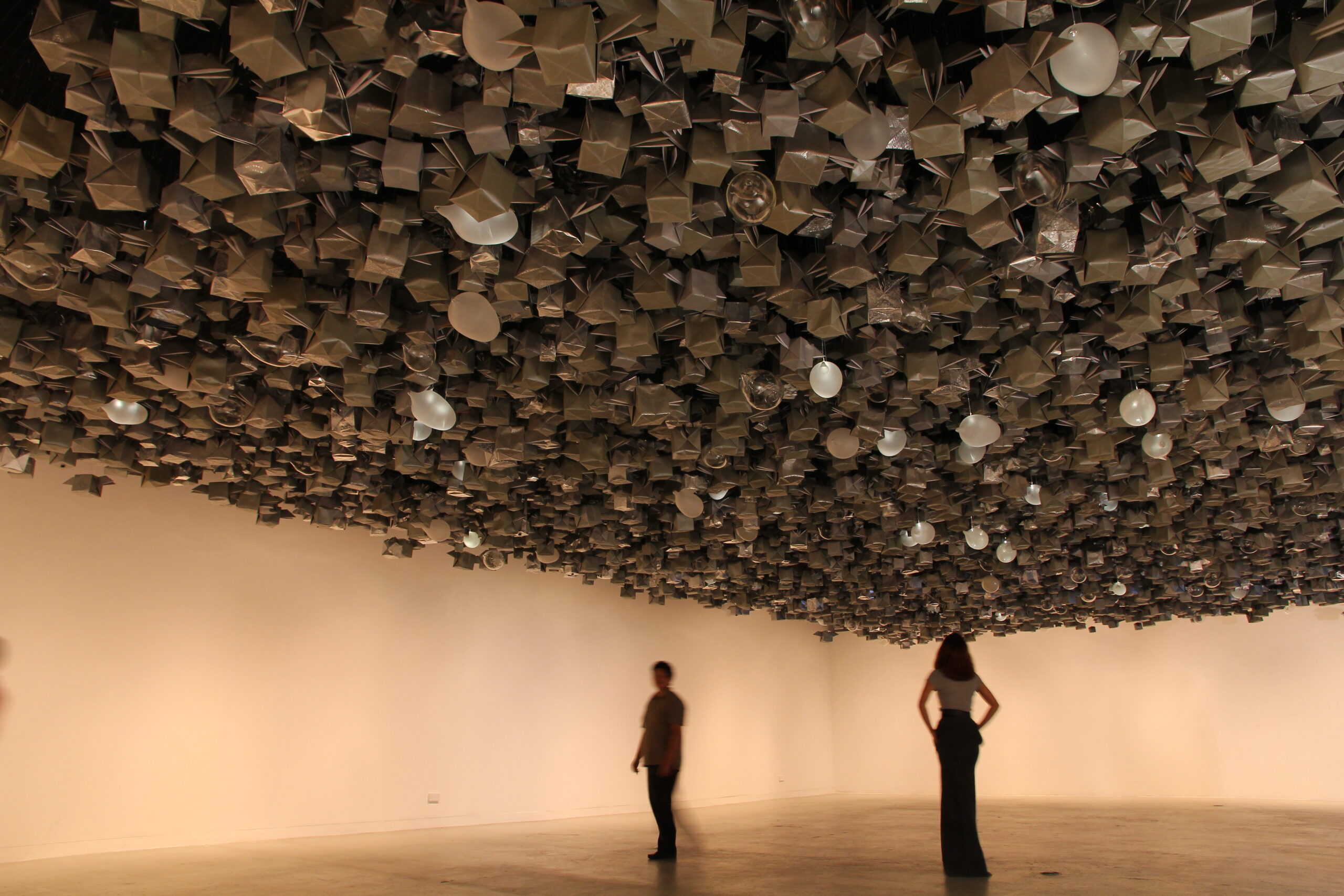
While I paint, my three assistants worked on the paper sculptures. I’m glad I am able to contribute to their income too as the food shop they started in early 2021 was on and off due to lockdowns and covid regulations.
Then the Bangkok Art Biennale (BAB)’s invitation came along. It was difficult to turn down. We are going to bring out “Temporary Insanity” (2004) and “Anything Can Break” (2011). Two large interactive installations with sound. I am looking forward to this very much. It will be the first time to install these two works together. I have also invited two young composers to add to the soundtracks of “Anything Can Break”: Fian Bhadranavik and Patravadi School Hua Hin, and “Yaboi Hanoi” Lamtharn Hantrakul along with the first 2 sound sets by Jeffrey Calman, Avi Sills, Amir Efrat and Tim Gruchy. It’s towards the end of the year but we are starting work right away — developing the sound system, checkups on equipment, folding more origami to help with the acoustics, planning logistics, etc. A lot of administration work on my side, working with all(zone) the architects, the programmer and BAB. Logistics are challenging, especially now with the war on top of the pandemic and rising fuel prices. Anyhow, I know it will work out at the end somehow. Just keep calm, paint, gardening, cooking and help out as much as you can.

Pinaree Sanpitak will be presenting works with Yavuz Gallery at ART SG 2023.
ABOUT THE AUTHOR: TAN SIULI
Tan Siuli is an independent curator with over a decade of experience encompassing the research, presentation and commissioning of contemporary art from Southeast Asia. Major exhibition projects include two editions of the Singapore Biennale (2013 and 2016), inter-institutional traveling exhibitions, as well as mentoring and commissioning platforms such as the President’s Young Talents exhibition series. She has also lectured on Museum-based learning and Southeast Asian art history at institutes of higher learning in Singapore. Her recent speaking engagements include presentations on Southeast Asian contemporary art at Frieze Academy London and Bloomberg’s Brilliant Ideas series.
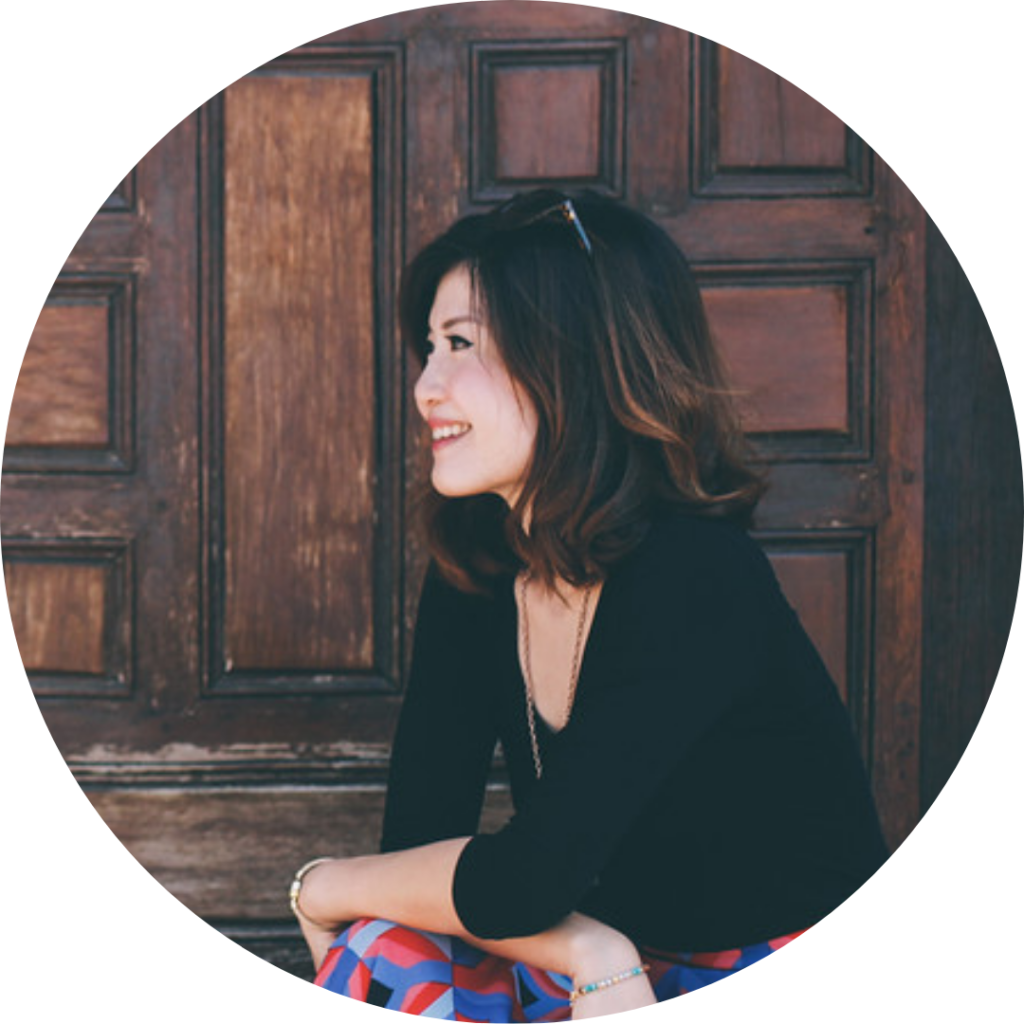
Share this article: